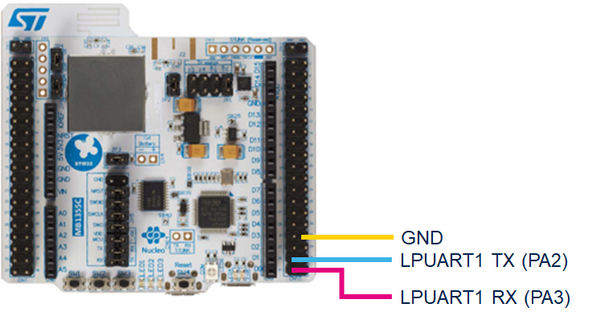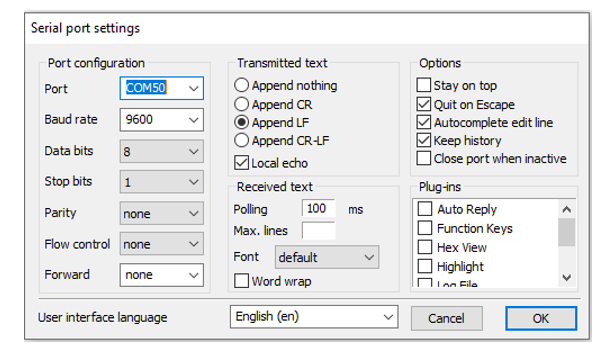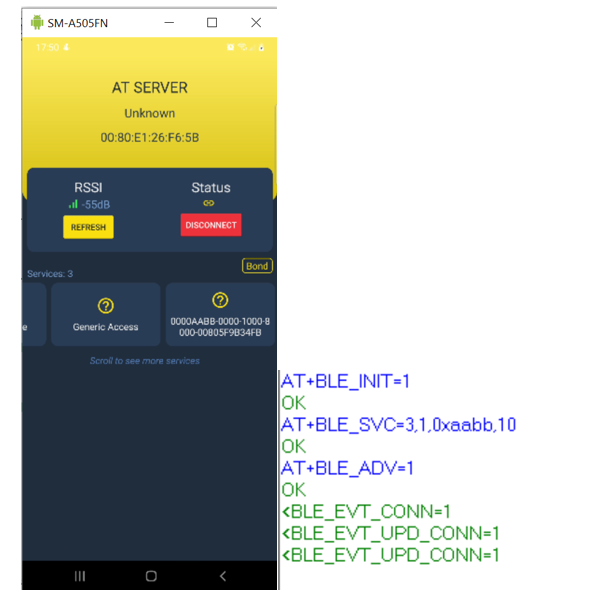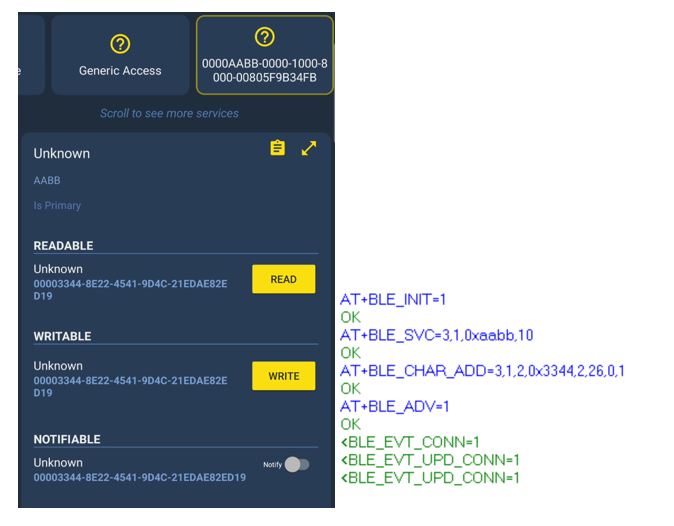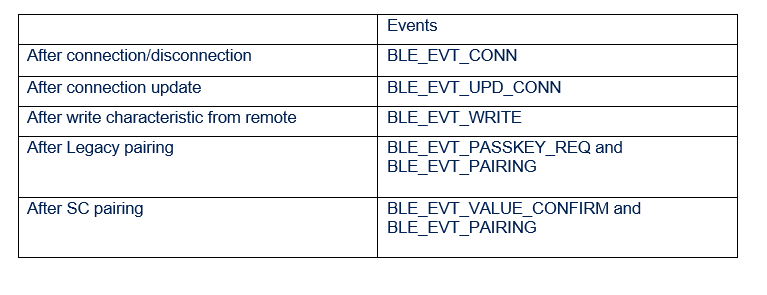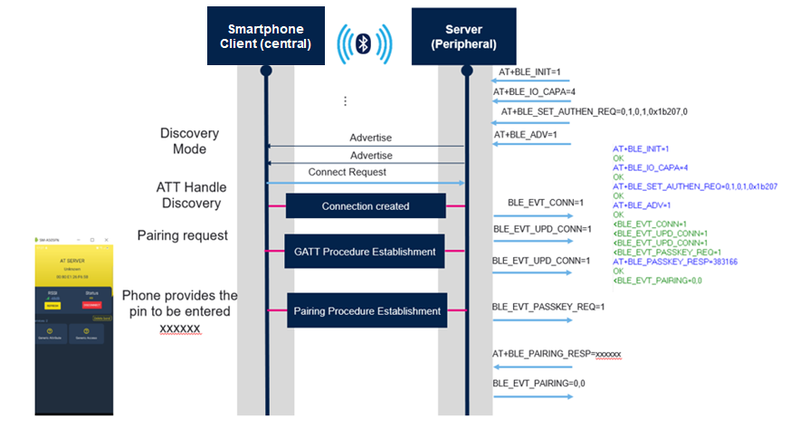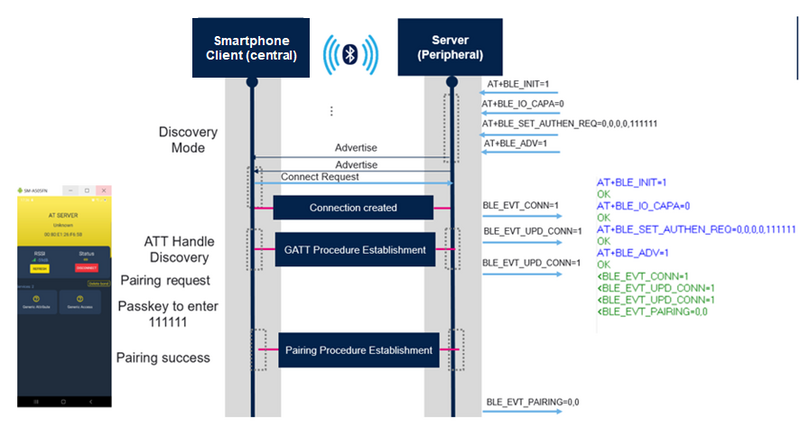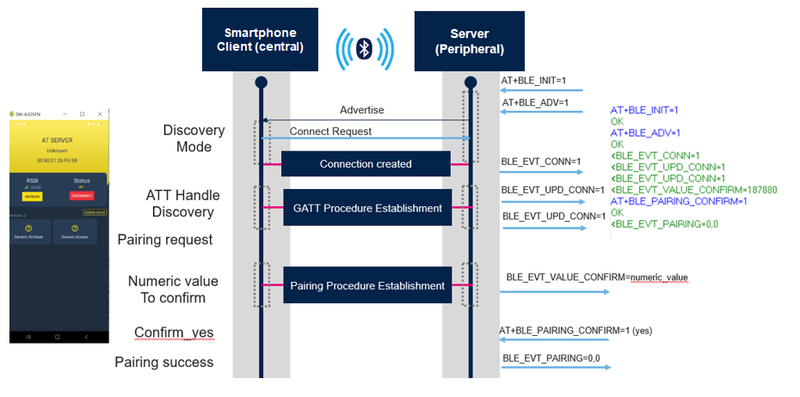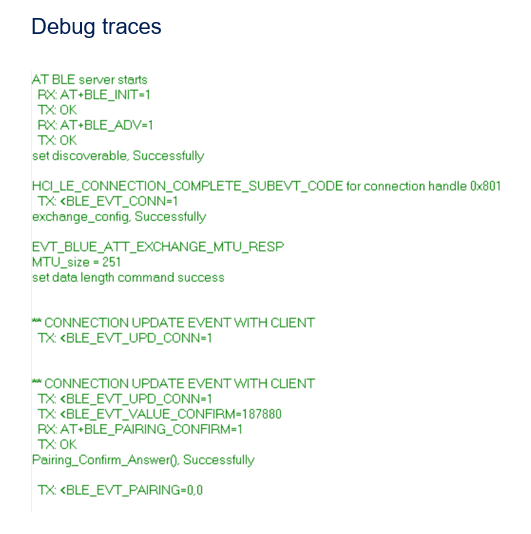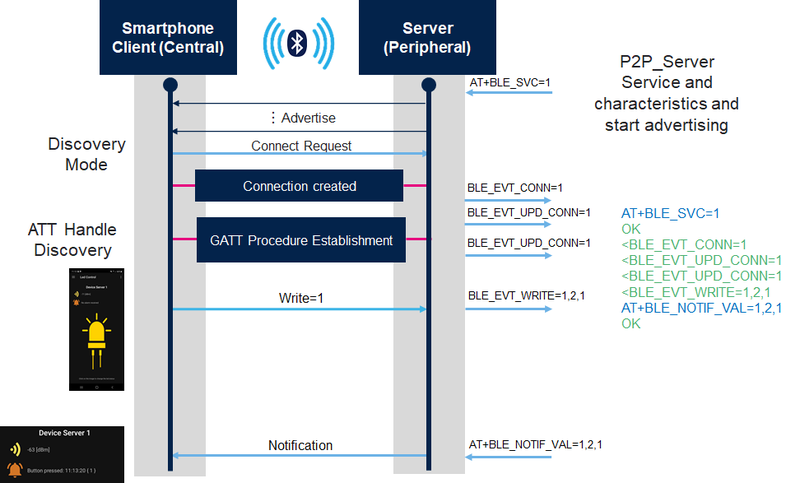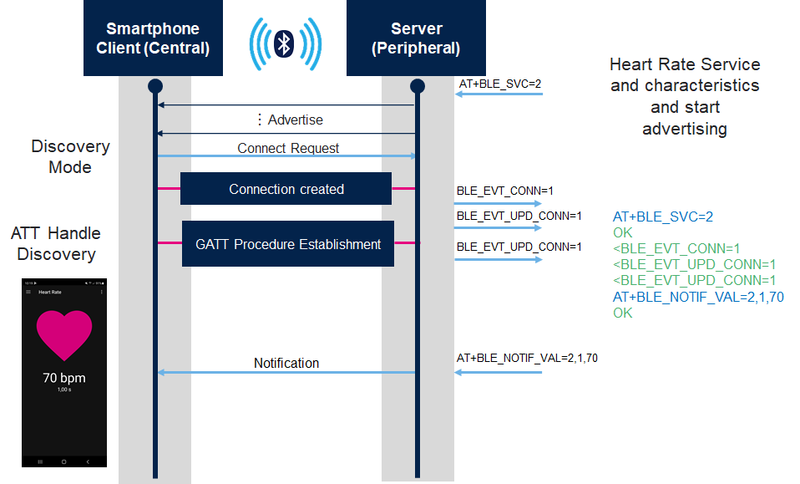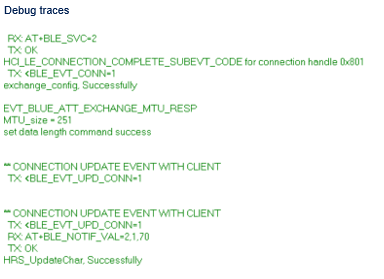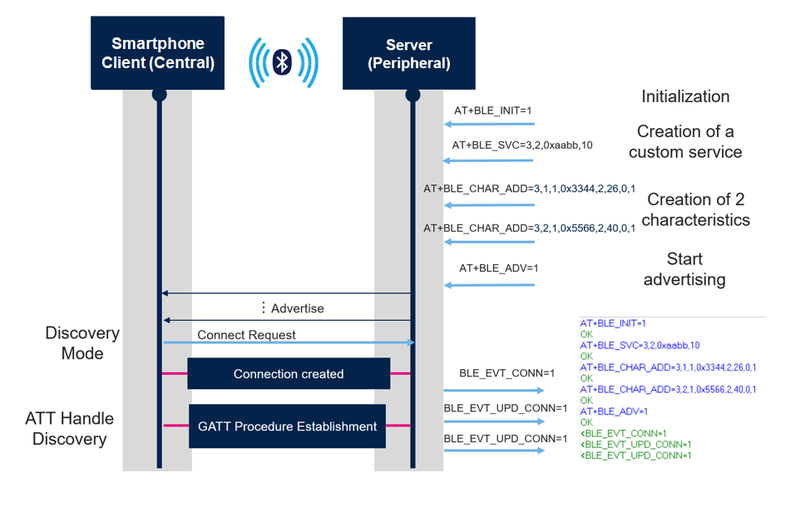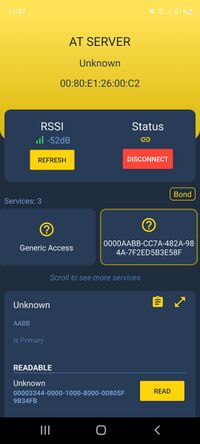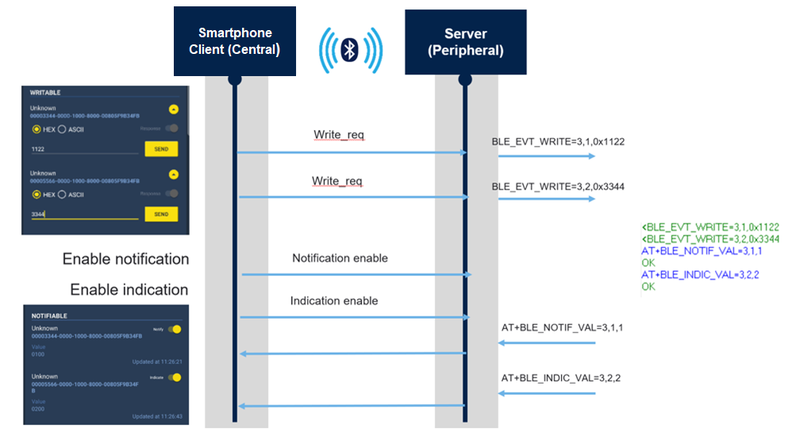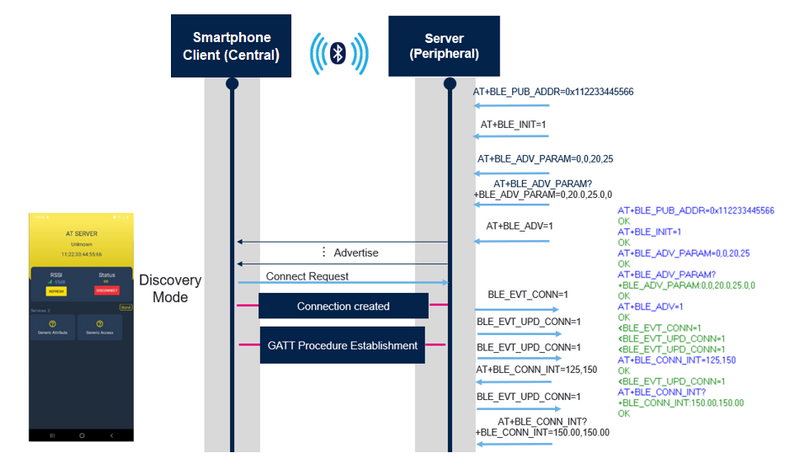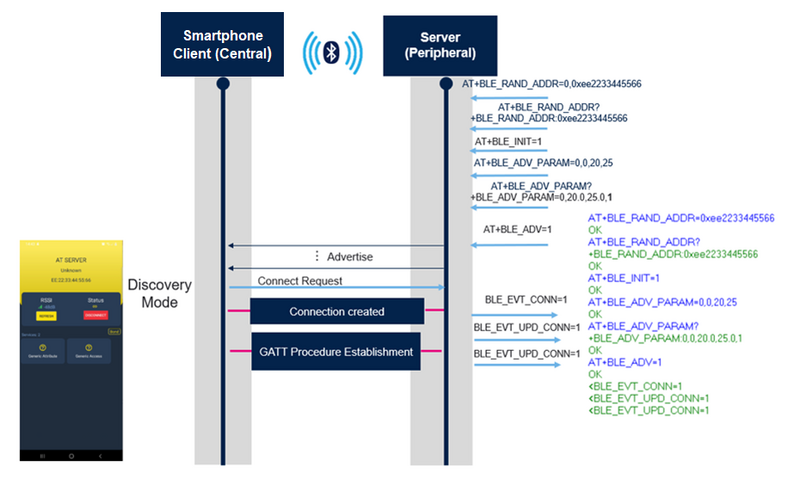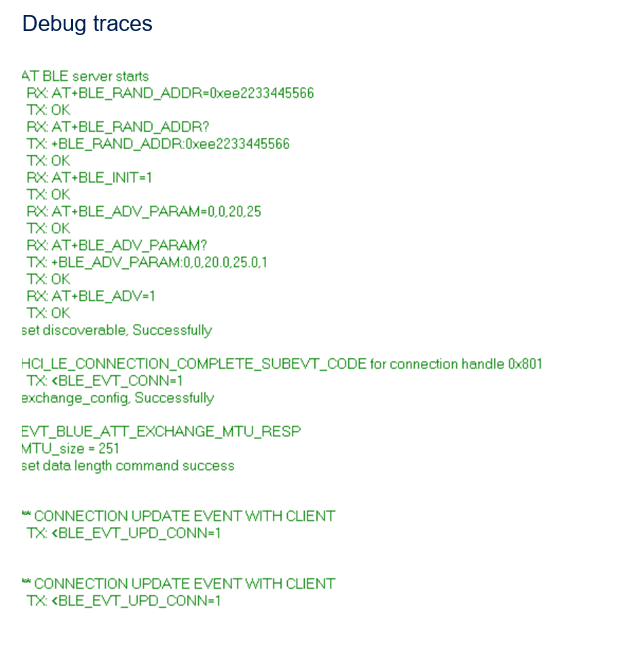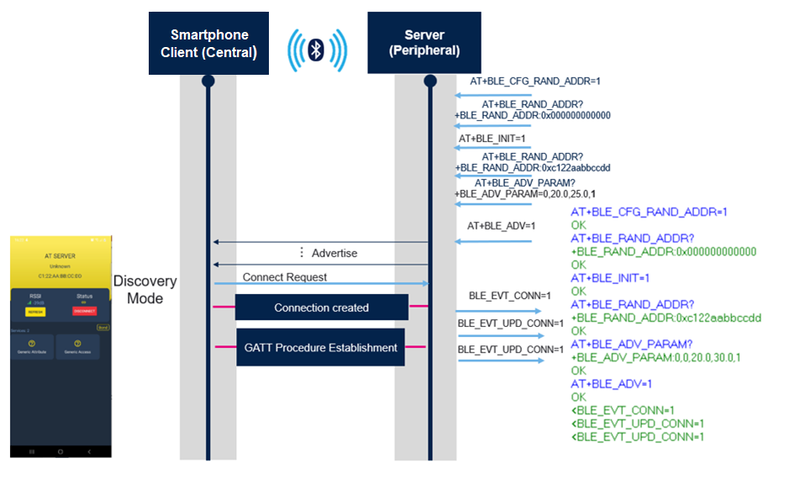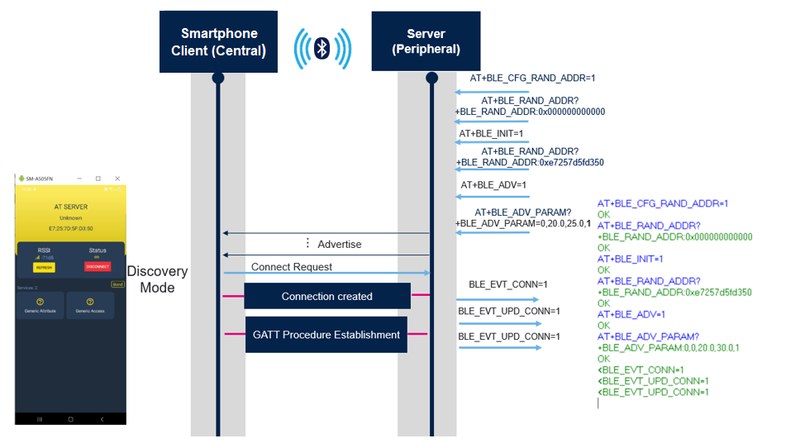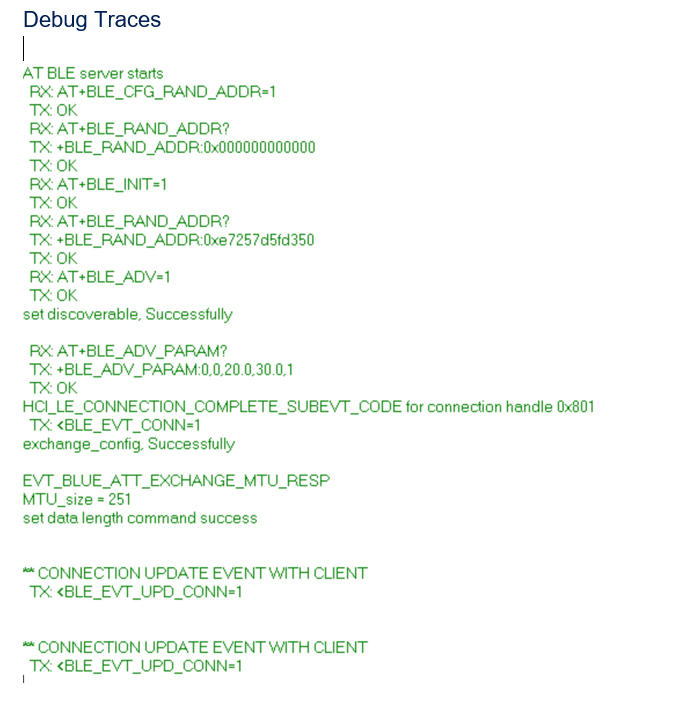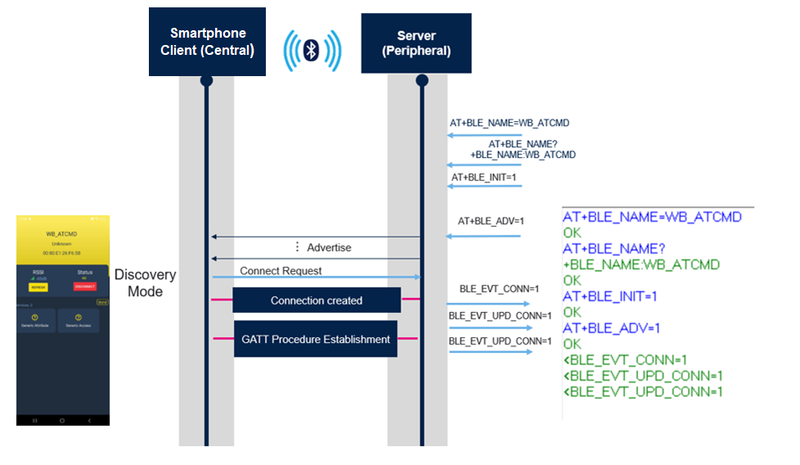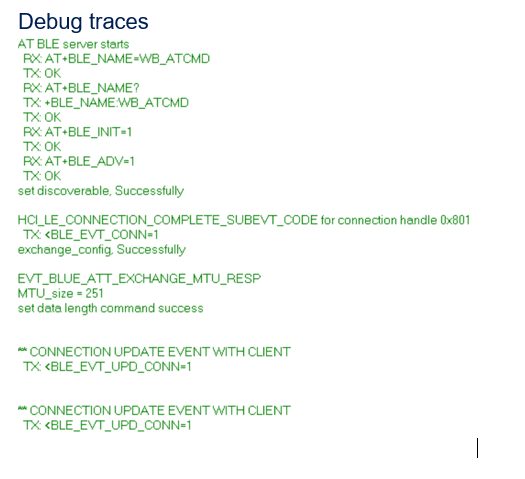1. STM32WB - Bluetooth® Low Energy (BLE) AT server overview
This page describes the set of AT commands to control the STM32WB Series. AT commands are instructions used to control a modem. AT is the abbreviation of ATtention. For this concept, the Cortex®-M4 application microcontroller contains an AT project able to manage the concepts of GAP, GATT, security and low-power. This document explains how to interface with the STM32WB Series microcontroller to manage multi Bluetooth® Low Energy applications handling (such as AT P2P server, AT Heart Rate) and GAP/GATT custom applications using AT instructions.
The BLE_AT_Server application is available by downloading STM32CubeWB[1] release.
This project implements a set of AT commands used to build GAP/GATT custom server application. It also implements P2P server or heart rate applications that can be directly selected. The objective is to have an intermediate abstraction layer in order to allow a user to develop a basic application with a limited sets of commands to send.
The following sections contain the interface description, the AT commands definition, and the description of some use cases.
1.1. AT commands
The AT instruction set is a standard developed by Hayes to control modems. The command set consists in a series of short text strings for performing operations:
- at GAP level such as advertising, discovery, connection, security
- at GATT level such as services and characteristics management and discovery, and operation on characteristics
The AT instructions are transferred through Cortex®-M4 application microcontroller low-power UART (LPUART) without flow control.
The STM32WB Series microcontroller can be controlled either through a terminal emulator such as Tera Term or Termite, or through an embedded microcontroller running AT client application like B-U585I-IOT02A[2] (STM32U5 connected via LPUART to STM32WB module).
| AT instruction architecture |
|---|
On P-NUCLEO-WB55 board use PA2 (CN 10 pin 35) for LPUART1 TX and PA3 (CN10 pin 37) for LPUART1 RX:
| P-NUCLEO-WB55 LPUART1 |
|---|
The terminal emulator must be configured with the following parameters:
• Baud rate: 9600 • Data: 8 bits • Parity: none • Stop: 1 bit • Flow control: none • Each frame is delimited by a \n character
| Terminal emulator configuration |
|---|
Thanks to the debug log via UART interface, it is possible to have debug trace of the application project.
AT command is composed of SET and QUERY operations. A single operation can be executed at a time. The format of these operations is defined as follows:
- SET operation:
- AT+CMD=value
- Response for SET operation:
- OK or ERROR
- QUERY operation:
- AT+CMD?
- Response for QUERY operation:
- +CMD:value
- OK
Event can be sent asynchronously by the server with the following format:
- <EVT=value
1.2. General commands
Initialization commands:
| GAP Command | Description | Comments |
|---|---|---|
| BLE_RST | Reset the Link Layer | |
| BLE_PUB_ADDR | Initializes public address | If needed, to be done before BLE_INIT |
| BLE_CFG_RAND_ADDR | Uses the default random address (defined in application) | If needed, to be done before BLE_INIT |
| BLE_RAND_ADDR | Initializes random address | If needed, to be done before BLE_INIT |
| BLE_NAME | Sets the name of the device | If needed, to be done before BLE_INIT |
| BLE_RF_POWER | Sets the TX power level of the device | Entered in dBm. See available values |
| BLE_INIT | Initializes public and random addresses, TX power level, name of the device: default values are used if not defined with previous AT commands. Sets default init values for the security | Default security values can be modified with BLE_IO_CAPA and BLE_SET_AUTHEN_REQ |
| BLE_IO_CAPA | Sets IO capability | Can be done before or after BLE_INIT |
| BLE_SET_AUTHEN_REQ | Sets authentication requirement of the device | Can be done before or after BLE_INIT |
| BLE_SVC | Initializes a predefined service (P2P server or Heart Rate) | BLE_SVC=1 creates service and characteristics for P2P_server service and starts advertising. BLE_SVC=2 creates service and characteristics for Heart_Rate service and starts advertising. |
GAP commands:
| GAP Command | Description | Comments |
|---|---|---|
| BLE_ADV_PARAM | Sets advertising parameters | |
| BLE_ADV | Starts, stops advertising | If no new defined advertising parameter, use of default parameters |
| BLE_CONN_INT | Updates the connection interval | To send after link establishment if needed |
| BLE_CLEAR_DB | Clears the security database | |
| BLE_PERIPH_SEC_REQ | Sends a peripheral security request to the central | To send after link establishment if needed |
| BLE_PAIRING_CONFIRM | Allows the user to confirm or the numeric comparison value showed through BLE_EVT_VALUE_CONFIRM | Used to answer BLE_EVT_VALUE_CONFIRM event |
| BLE_PASSKEY_RESP | Sends the passkey to use during the pairing process, in response to BLE_EVT_PASSKEY_REQ | Used to answer BLE_EVT_PASSKEY_REQ event |
GATT commands:
| GATT Command | Description | Comments |
|---|---|---|
| BLE_SVC | Initialize a service | BLE_SVC=3 to 5 creates a custom service |
| BLE_CHAR_ADD | Add a characteristic | Applicable to a custom service |
| BLE_NOTIF_VAL | Sets the characteristic value to be notified | value sent from the server to the client |
| BLE_INDIC_VAL | Sets the characteristic value to be indicated | value sent from the server to the client |
GAP events:
| GAP events | Description | Comments |
|---|---|---|
| BLE_EVT_CONN | After connection/disconnection | |
| BLE_EVT_UPD_CONN | After connection update | |
| BLE_EVT_PASSKEY_REQ | After pairing request (legacy pairing) | Needs to be answered with BLE_PASSKEY_RESP |
| BLE_EVT_VALUE_CONFIRM | After pairing request (secure connection) | Needs to be answered with BLE_PAIRING_CONFIRM |
| BLE_EVT_PAIRING | AT the end of pairing process | Returns status and reason parameters |
GATT events:
| GATT events | Description | Comments |
|---|---|---|
| BLE_EVT_WRITE | After characteristic write | Sent when a client writes a characteristic |
2. Initialization commands
2.1. Initialization - reset - BLE_RST
SET operation: <1>
AT+BLE_RST=1 OK
QUERY operation: no query for this command, it returns an error.
2.2. Initialization - public address - BLE_PUB_ADDR
Public address is 6 bytes address.
SET operation: <address>
AT+BLE_PUB_ADDR=0x112233445566 OK
QUERY operation: <public address>
AT+BLE_PUB_ADDR? + BLE_PUB_ADDR: 0x112233445566 OK
2.3. Initialization - use of default random address – BLE_CFG_RAND_ADDR
SET operation: <1>
AT+BLE_CFG_RAND_ADDR=1 OK
QUERY operation: <config random address>
AT+BLE_CFG_RAND_ADDR? +BLE_CFG_RAND_ADDR=1 OK
2.4. Initialization - random address – BLE_RAND_ADDR
Random address is 6 bytes address.
SET operation: <address>
AT+BLE_RAND_ADDR=0xFF11223344CC OK
QUERY operation: <random address>
AT+BLE_RAND_ADDR? + BLE_RAND_ADDR: 0xFF11223344CC OK
2.5. Initialization - name – BLE_NAME
Device name is a string of characters (maximum of 19 characters)
SET operation: <name>
AT+BLE_NAME=WB_ATCMD OK
QUERY operation: <name>
AT+BLE_NAME? +BLE_NAME=WB_ATCMD OK
2.6. Initialization - Tx power – BLE_RF_POWER
Tx power value is between -40 dBm to 6 dBm (IC level). List of supported values in dBm:
-40 -20,85 -19,75 -18,85 -17,6 -16,5 -15,25 -14,1 -13,15 -12,05 -10,9 -9,9 -8,85 -7,8 -6,9 -5,9 -4,95 -4 -3,15 -2,45 -1,8 -1,3 -0,85 -0,5 -0,15 0 1 2 3 4 5 6
SET operation: <tx power>
AT+BLE_RF_POWER=1 OK
QUERY operation: <tx power>
AT+BLE_RF_POWER? + BLE_RF_POWER:1 OK
2.7. Initialization - BLE_INIT
BLE_INIT to be used in case of custom application.
If AT+BLE_INIT=1 is the first sent command, initialization of the following parameters is done:
Public address, random address, device name, RF Tx power, security parameters.
The default values applied in this case are:
- Public address: based on the company ID, the device ID and the Unique Device Number (UDN)
- bit[47:24] : 24bits (OUI) equal to the company ID
- bit[23:16] : Device ID.
- bit[15:0] : The last 16bits from the UDN
- bit[47:24] : 24bits (OUI) equal to the company ID
- Random address: based on the UDN and a defined value (0x0000ED6E) to fit the requirements of a random address.
- Device name: AT SERVER
- RF Tx power: -0.15 dBm
- IO Capability: IO_CAP_KEYBOARD_DISPLAY (4)
- Authentication requirements: no bonding mode (0), MITM (1), SC support supported but optional (1), no use of fixed pin (1), fixed pin (111111), public address (0)
If the public address, the random address, the name or the tx output power needs to be changed, send associated AT commands, BLE_PUB_ADDR, BLE_RAND_ADDR, BLE_NAME, BLE_RF_POWER before BLE_INIT.
If IO capability, authentication requirements parameters need to be changed, send BLE_IO_CAPA, BLE_SET_AUTHEN_REQ before or after BLE_INIT out of any link establishment.
SET operation: <1>
Use default BD address, default name, default Tx Power if no new parameter has been defined.
Default initialization in case security (pairing) is started after link establishment. These values can be changed when no link is established with BLE_IO_CAPA and BLE_SET_AUTHEN_REQ (commands described later).If BLE_PUB_ADDR,
BLE_RAND_ADDR,
BLE_NAME or BLE_RF_POWER have been sent previously, the new parameters are taken into account.
AT+BLE_INIT=1 OK
QUERY operation: <public_addr>, <name>, <tx power>
AT+BLE_INIT? +BLE_INIT:0x0080e12600c2,AT server,-0.15 OK
2.8. Initialization - IO capability - BLE_IO_CAPA
IO capability values :
- 0: IO_CAP_DISPLAY_ONLY
- 1: IO_CAP_DISPLAY_YES_NO
- 2: IO_CAP_KEYBOARD_ONLY
- 3: IO_CAP_NO_INPUT_NO_OUTPUT
- 4: IO_CAP_KEYBOARD_DISPLAY
SET operation: <io_capability>
AT+BLE_IO_CAPA=1 OK
QUERY operation: <io_capability>
AT+BLE_IO_CAPA? +BLE_IO_CAPA:1 OK
2.9. Initialization - authentication requirement - BLE_SET_AUTHEN_REQ
Sets authentification requirement of the device :
bonding_mode:
- 0: no bonding mode’
- 1: bonding mode
mitm:
- 0: no MITM
- 1: MITM
sc_support:
- 0: SC pairing not supported
- 1: SC pairing supported but optional
- 2: SC pairing mandatory
use_fixed_pin:
- 0: use a fixed pin
- 1: do not use a fixed pin
fixed_pin:
- 0 to 999999
SET operation: <bonding_mode>, <mitm>, <sc_support>, <use_fixed_pin>, <fixed_pin>
AT+BLE_SET_AUTHEN_REQ=0,0,1,1,0000 OK
QUERY operation: <bonding_mode>, <mitm>, <sc_support>, <use_fixed_pin>, <fixed_pin>,<identity_address_type>
AT+BLE_SET_AUTHEN_REQ? +BLE_SET_AUTHEN_REQ:0,0,1,1,0x0,0 OK
2.10. Initialization commands – P2P_server or heart rate service creation – BLE_SVC
If BLE_SVC=1 or BLE_SVC=2 is sent, no need to send BLE_INIT.
BLE_SVC=1 creates service and characteristics for P2P_server service and starts advertising.
BLE_SVC=2 creates service and characteristics for Heart_Rate service and starts advertising.
Use a phone with ST BLE Sensor application to connect to P2P server or Heart rate application.
Services available:
- 0: no service
- 1: P2P service
- 2: Heart Rate
SET operation: <svc_id>
- Creates P2P_server service and starts advertising
AT+BLE_SVC=1 OK
- Creates heart rate service and starts advertising
AT+BLE_SVC=2 OK
QUERY operation: <svc_id>
Returns the active service.
AT+BLE_SVC? +BLE_SVC:2 OK
3. GAP commands
3.1. GAP command - advertising set parameters – BLE_ADV_PARAM
Sets advertising parameters of the device:
entry_nb:
- 1: 0,20ms,30ms,0
- 2: 0,180ms,200ms,0
- 3: 0,1s,2.5s,0
- 0, <adv_type>, <adv_int_min>, <adv_int_max>
adv_type:
- 0: connectable undirected advertising
- 1: connectable directed advertising
- 2: scannable undirected advertising
- 3: not connectable undirected advertising
adv_int_min:
- From 20 ms to 10240 ms (must be multiple of 0.625 ms)
adv_int_max:
- From 20 ms to 10240 ms (must be multiple of 0.625 ms)
SET operation: <entry_nb>
AT+BLE_ADV_PARAM=2 OK
AT+BLE_ADV_PARAM=0,0,32,48 OK
QUERY operation: <entry_nb> <adv_type>, <adv_int_min>, <adv_int_max>, <own_addr_type>
AT+BLE_ADV_PARAM? +BLE_ADV_PARAM:2,0,180.0,200.0,0 OK
AT+BLE_ADV_PARAM? +BLE_ADV_PARAM:0,0,32.0,48.0,0 OK
3.2. GAP command - start/stop advertising – BLE_ADV
Start/stop advertising:
- 0: stop advertising
- 1: start advertising
If no param entered, use default values (config 1)
If predefined config, use (1,2 or 3)
If param entered, use the new parameters
SET operation: <enable>
AT+BLE_ADV=1 OK
QUERY operation: <enable>
AT+BLE_ADV? +BLE_ADV:1 OK
3.3. GAP command - connection update – BLE_CONN_INT
Connection interval values:
conn_int_min: From 7,5 ms to 4000 ms (must be multiple of 1.25 ms) conn_int_max: From 7,5 ms to 4000 ms (must be multiple of 1.25 ms)
SET operation: <conn_int_min>,<conn_int_max>
AT+BLE_CONN_INT=125,150 OK
QUERY operation: <conn_int_min>,<conn_int_max>
AT+BLE_CONN_INT? +BLE_CONN_INT:125.00,150.00 OK
3.4. GAP command - clear the security database – BLE_CLEAR_DB
SET operation: <1>
AT+BLE_CLEAR_DB = 1 OK
QUERY operation: no query for this command, it returns an error.
3.5. GAP command - sends a peripheral security request to the central – BLE_PERIPH_SEC_REQ
SET operation: <1>
AT+BLE_PERIPH_SEC_REQ = 1 OK
QUERY operation: No query for this command, it returns an error.
3.6. GAP command - confirms or not the numeric comparison value in secure Connection - BLE_PAIRING_CONFIRM
Confirms or not the numeric comparison value in secure connection:
- 0: to not confirm the numeric comparison value
- 1: to confirm the numeric comparison value
SET operation: <confirm_yes_no>
AT+BLE_PAIRING_CONFIRM=1 OK
QUERY operation: no query for this command, it returns an error.
On reception of BLE_EVT_VALUE_CONFIRM event, send AT+BLE_PAIRING_CONFIRM=<confirm_yes_no>, see example here.
3.7. GAP command - sends the passkey to use during the pairing process in legacy pairing - BLE_PASSKEY_RESP
Passkey value is between 0 and 999999.
SET operation: <passkey>
AT+BLE_PASSKEY_RESP=0000 OK
QUERY operation: no query for this command, it returns an error.
On reception of BLE_EVT_PASSKEY_REQ, send AT+BLE_PASSKEY_RESP=<passkey>, see example here.
When the pairing is complete, reception of BLE_EVT_PAIRING event with two parameters: status, reason.
Status:
- 0: pairing status success
- 1: pairing status timeout
- 2: pairing failed
- 3: encryption failed
Reason:
- 1: passkey entry failed
- 2: OOB not available
- 3: authentication request cannot be met
- 4: confirm value failed
- 5: pairing not supported
- 6: insufficient encryption key size
- 7: command not supported
- 8: unspecified reason
- 9: very early next attempt
- 10: invalid parameters
- 11: SC DHKEY check failed
- 12: SC numeric comparison failed
4. GATT commands
4.1. GATT command - custom service creation - BLE_SVC
For the creation of a custom service, the command BLE_INIT is mandatory.
Use a phone with ST BLE ToolBox to connect with WB55 and a custom service.
Custom service parameters:
svc_id:
- 0: no service
- 3 to 5: custom service
svc_uuid_type:
- 1: 16 bits
- 2: 128 bits
uuid_16b:
- 16 bits service uuid
max_attr_record:
- 2 * nb_of_char + 1
SET operation: <svc_id>, <svc_uuid_type>, <uuid_16b>, <max_attr_record>
AT+BLE_SVC=3,1,0xAABB,10 OK
QUERY operation: <svc_id>
AT+BLE_SVC? +BLE_SVC:3 OK
If svc_uuid_type = 1, a range of UUID values has been pre-allocated, it is the Bluetooth base UUID and it has the value 00000000-0000-1000-8000-
00805F9B34FB.
If svc_uuid_type = 2, the user enters 16 bits service uuid. The 128 bits service uuid is completed in BLE_AT_SERVER application with the following value 00000000-CC7A-482A-984A-7F2ED5B3E58F.
Example 1:
AT+BLE_INIT=1 OK AT+BLE_SVC=3,1,0xAABB,10 AT+BLE_ADV=1 OK
| Custom service creation 1 |
|---|
Example 2:
AT+BLE_INIT=1 OK AT+BLE_SVC=3,2,0xAABB,10 AT+BLE_ADV=1 OK
| Custom service creation 2 |
|---|
AT_SERVER: default complete local name 00:80:E1:26:F6:5B: default public BD address
Up to three custom services can be defined.
4.2. GATT command - characteristic creation - BLE_CHAR_ADD
Characteristic parameters:
svc_id:
- 3: service id on which characteristic is added
char_id:
- 1 to 5: characteristic id
char_uuid_type:
- 1: 16 bits
- 2: 128 bits
char_uuid_16b:
- 16 bits char uuid
char_value_len:
- 1 to 245
char_prop:
- 0x00: CHAR_PROP_NONE
- 0x01: CHAR_PROP_BROADCAST
- 0x02: CHAR_PROP_READ
- 0x04: CHAR_PROP_WRITE_WITHOUT_RESP
- 0x08: CHAR_PROP_WRITE
- 0x10: CHAR_PROP_NOTIFY
- 0x20: CHAR_PROP_INDICATE
- 0x40: CHAR_PROP_SIGNED_WRITE
- 0x80: CHAR_PROP_EXT
sec_permission:
- 0x00: None
- 0x01: AUTHEN_READ
- 0x02: AUTHOR_READ
- 0x04: ENCRY_READ
- 0x08: AUTHEN_WRITE
- 0x10: AUTHOR_WRITE
- 0x20: ENCRY_WRITE
gatt_evt_mask:
- 0x00: GATT_DONT_NOTIFY_EVENTS
- 0x01: GATT_NOTIFY_ATTRIBUTE_WRITE
- 0x02: GATT_NOTIFY_WRITE_REQ_AND_WAIT_FOR_APPL_RESP
- 0x04: GATT_NOTIFY_READ_REQ_AND_WAIT_FOR_APPL_RESP
SET operation: <svc_id>, <char_id>, <char_uuid_type>, <char_uuid_16b>, <char_value_len>, <char_prop>, <sec_permission>, <gatt_evt_mask>
AT+BLE_CHAR_ADD=3,1,1,0x3344,2,26,0,1 OK
QUERY operation: no query for this command, it returns an error.
If char_uuid_type = 1, a range of UUID values has been pre-allocated, it is the Bluetooth Base UUID and has the value 00000000-0000-1000-8000- 00805F9B34FB
If char_uuid_type = 2, the user enters 16 bits characteristic uuid. The 128 bits service uuid is completed in BLE_AT_SERVER application with the following value 00000000-8E22-4541-9D4C-21EDAE82ED19.
Example 1:
AT+BLE_CHAR_ADD=3,1,1,0x3344,2,26,0,1 OK
| Custom characteristic example 1 |
|---|
Example 2:
AT+BLE_CHAR_ADD=3,1,2,0x3344,2,10,0,1 OK
| Custom characteristic example 2 |
|---|
4.3. GATT command - setting of the characteristic value to notify - BLE_NOTIF_VAL
Parameters of BLE_NOTIF_VAL command:
svc_id:
- 1 to 5: service id corresponding to the characteristic to be notified
char_id:
- 1 to 5: characteristic id to be notified
char_val:
- value to be notified
SET operation: <svc_id>, <char_id>, <char_val>
- Sets heart rate measurement characteristic value to 70 for heart rate service:
AT+BLE_NOTIF_VAL=2,1,70 OK
By default, energy expended value is set to 0, it is not displayed on the phone.
- Sets button control characteristic status, 0 and 1 are displayed alternatively (char_val = 0 has no effect) for P2P service:
AT+BLE_NOTIF_VAL=1,2,1 OK
QUERY operation: no query for this command, it returns an error.
4.4. GATT command - setting of the characteristic value to indicate - BLE_INDIC_VAL
Parameters of BLE_INDIC_VAL command:
svc_id:
- 1 to 5: service id corresponding to the characteristic to be notified
char_id:
- 1 to 5: characteristic id to be notified
char_val:
- value to be notified
SET operation: <svc_id>, <char_id>, <char_val>
AT+BLE_INDIC_VAL=3,1,10 OK
QUERY operation: no query for this command, it returns an error.
5. Events generation
An event is an information received either from the remote device or from the local device to inform the application about the status change or the data received.
| Events description |
|---|
6. Security
The BLE security model includes five security features:
- Pairing: process for creating one or more shared secret keys.
- Bonding: act of storing the keys created during pairing for use in subsequent connections in order to form a trusted device pair.
- Device authentication: verification that the two devices have the same keys.
- Encryption: provides message confidentiality.
- Message integrity: protects against fake messages.(4 bytes message integrity check MIC)
BLE uses two security levels:
- Legacy pairing – short temporary key (STK). STK is created to encrypt connection. Then, if bonding, LTK is used for subsequent connections.
- Secure connection – long term key (LTK). LTK is created to encrypt connection.
6.1. Legacy pairing and no fixed pin (initiated by the central)
Default initialization values can be changed when no link is established with:
BLE_IO_CAPA=4 BLE_SET_AUTHEN_REQ=0,1,0,1,111111 (fixed pin is not used)
| Legacy pairing with no fixed pin exchange sequence |
|---|
6.2. Legacy pairing and fixed pin (111111) (initiated by the central)
Default initialization values can be changed when no link is established with:
BLE_IO_CAPA=0 BLE_SET_AUTHEN_REQ=0,0,0,0,111111 (fixed pin = 111111 is used)
| Legacy pairing with fixed pin exchange sequence |
|---|
6.3. Secure connection (initiated by the central)
Use of default values when BLE_INIT is sent:
io_capability = 4 bonding_mode = 0 mitm = 1 sc_support = 1 use_fixed_pin = 1 fixed_pin = 111111 identity_address_type = 0
| Secure connection (initiated by the central) exchange sequence |
|---|
7. Flow sequences for examples
7.1. First demonstration using predefined applications
7.1.1. BLE_SVC=1 P2P_server
Steps to use P2P_server application:
- Power on your board running BLE_AT_Server application
- Open a terminal emulator to send data to STM32WB LPUART1 interface.
- Send AT+BLE_SVC=1 command : creates P2P_server service and starts advertising. OK is received
- Then, open ST BLE Sensor smartphone application and connect to P2PSRV1 device
- Events are received over LPUART:
- BLE_EVT_CONN=1
- BLE_EVT_UPD_CONN=1
- BLE_EVT_UPD_CONN=1
- Play with the light on the smartphone, events are received over LPUART:
- BLE_EVT_WRITE=1,2,x with x = 0 led off, x = 1 led on
- Send over the LPUART AT+BLE_NOTIF_VAL=1,2,1 command – toggles button characteristic status, (AT+BLE_NOTIF_VAL=1,2,0 has no effect), on the smartphone "Button pressed: hh:mm:ss {status}" is displayed. OK is received
| P2P Server exchange sequence |
|---|
7.1.2. BLE_SVC=2 heart rate
Steps to use the heart rate application:
- Power on your board running BLE_AT_Server application
- Open a terminal emulator to send data to STM32WB LPUART1 interface
- Send AT+BLE_SVC=2 command : creates Heart Rate service and starts advertising. OK is received
- Then, open ST BLE Sensor smartphone application and connect to HRSTM device
- Events are received over LPUART:
- BLE_EVT_CONN=1
- BLE_EVT_UPD_CONN=1
- BLE_EVT_UPD_CONN=1
- Send over the LPUART AT+BLE_NOTIF_VAL=2,1,70 command – sets heart rate measurement characteristic value to 70. OK is received
| Heart Rate exchange sequence |
|---|
7.2. Second demonstration: creating a custom service
7.2.1. BLE_SVC=3 Custom service
Steps to create custom service:
- Power on your board running BLE_AT_Server application
- Open a terminal emulator to send data to STM32WB LPUART1 interface
- Send AT+BLE_INIT=1 command, initialization. OK is received
- Send AT+BLE_SVC=3,2,0xaabb,10 command, creation of a custom service. OK is received
- Send AT+BLE_CHAR_ADD=3,1,1,0x3344,2,26,0,1 command, creation of a characteristic with properties: read, write, notify. OK is received
- Send AT+BLE_CHAR_ADD=3,2,1,0x5566,2,40,0,1 command, creation of a second characteristic with properties: write, indicate. OK is received
- Send AT+BLE_ADV=1, starts advertising. OK is received
- Then, open ST BLE ToolBox smartphone application and connect to AT_SERVER device, discover service and characteristics.
- Events are received over LPUART:
- <BLE_EVT_CONN=1
- <BLE_EVT_UPD_CONN=1
- <BLE_EVT_UPD_CONN=1
| Creation of custom service exchange sequence |
|---|
- Click on your custom service on ST BLE ToolBox
| ST BLE ToolBox Custom service |
|---|
Write characteristics, enable notification and indication:
- On the first writable characteristic, click on the write button, enter the value to write for example 0x1122 and click on send. Value is written on service 3, characteristic 1.
- Event is received over LPUART:
- <BLE_EVT_WRITE=3,1,0x1122
- Same thing on the second writable characteristic, write 0x3344 value.
- Event is received over LPUART:
- <BLE_EVT_WRITE=3,2,0x3344
- On notifiable characteristics, click on Notify for characteristic 1 to enable notification and click on Indicate for characteristic 2 to enable indication.
- Send AT+BLE_NOTIF_VAL=3,1,1 command, OK is received. Notification received on the smartphone.
- Send AT+ BLE_INDIC_VAL=3,2,1 command, OK is received. Indication received on the smartphone.
| Characteristic management exchange sequence |
|---|
Initialization sequence with specific parameters, change of connection interval:
- Send AT+BLE_PUB_ADDR=0x112233445566 command, configuration of public address. OK is received
- Send AT+BLE_INIT=1 command, initialization. OK is received
- Send AT+BLE_ADV_PARAM=0,0,20,25 command, configuration of advertising parameters. OK is received
- Send AT+BLE_ADV_PARAM? command to check advertising parameters.
- +BLE_ADV_PARAM:0,0,20.0,25.0,0 is received
- OK is received
- Send AT+BLE_ADV=1 command, starts advertising. OK is received
- Then, open ST BLE ToolBox smartphone application and connect to AT_SERVER device, discover service and characteristics.
- Events are received over LPUART:
- <BLE_EVT_CONN=1
- <BLE_EVT_UPD_CONN=1
- <BLE_EVT_UPD_CONN=1
- Send AT+BLE_CONN_INT=125,150 command, change connection interval. OK is received
- Events are received over LPUART:
- <BLE_EVT_UPD_CONN=1
- Send AT+BLE_CONN_INT? command to check connection interval.
- +BLE_CONN_INT:150.00,150.00 is received
- OK is received
| Initialization sequence with specific parameters, change of connection interval |
|---|
Initialization sequence with random address defined by the user:
- Send AT+BLE_RAND_ADDR=0xee2233445566 command, configuration of random address. OK is received
- Send AT+BLE_RAND_ADDR? command to check random address.
- +BLE_RAND_ADDR:0xee2233445566 is received
- OK is received
- Send AT+BLE_INIT=1 command, initialization. OK is received
- Send AT+BLE_ADV_PARAM=0,0,20,25 command, configuration of advertising parameters. OK is received
- Send AT+BLE_ADV_PARAM? command to check advertising parameters.
- +BLE_ADV_PARAM:0,0,20.0,25.0,0 is received
- OK is received
- Send AT+BLE_ADV=1 command, starts advertising. OK is received
- Then, open ST BLE ToolBox smartphone application and connect to AT_SERVER device, discover service and characteristics.
- Events are received over LPUART :
- <BLE_EVT_CONN=1
- <BLE_EVT_UPD_CONN=1
- <BLE_EVT_UPD_CONN=1
| Initialization sequence with random address defined by the user |
|---|
Initialization sequence with default random address (CFG_STATIC_RANDOM_ADDRESS defined in app_conf.h):
- Send AT+BLE_CFG_RAND_ADDR=1 command, configuration of random address. OK is received
- Send AT+BLE_RAND_ADDR? command to check random address.
- +BLE_RAND_ADDR:0x000000000000 is received
- OK is received
- Send AT+BLE_INIT=1 command, initialization. OK is received
- Send AT+BLE_RAND_ADDR? command to check random address.
- +BLE_RAND_ADDR:0xc122aabbccdd is received
- OK is received
- Send AT+BLE_ADV_PARAM? command to check advertising parameters.
- +BLE_ADV_PARAM:0,0,20.0,30.0,0 is received
- OK is received
- Send AT+BLE_ADV=1 command, starts advertising. OK is received
- Then, open ST BLE ToolBox smartphone application and connect to AT_SERVER device, discover service and characteristics.
- Events are received over LPUART:
- <BLE_EVT_CONN=1
- <BLE_EVT_UPD_CONN=1
- <BLE_EVT_UPD_CONN=1
| Initialization sequence with default random address |
|---|
Initialization sequence with default random address generated with random generator (CFG_STATIC_RANDOM_ADDRESS not defined in app_conf.h):
- Send AT+BLE_CFG_RAND_ADDR=1 command, configuration of random address. OK is received
- Send AT+BLE_RAND_ADDR? command to check random address.
- +BLE_RAND_ADDR:0x000000000000 is received
- OK is received
- Send AT+BLE_INIT=1 command, initialization. OK is received
- Send AT+BLE_RAND_ADDR? command to check random address.
- +BLE_RAND_ADDR:0xe7257d5fd350 is received
- OK is received
- Send AT+BLE_ADV=1 command, starts advertising. OK is received
- Send AT+BLE_ADV_PARAM? command to check advertising parameters.
- +BLE_ADV_PARAM:0,0,20.0,30.0,1 is received
- OK is received
- Then, open ST BLE ToolBox smartphone application and connect to AT_SERVER device, discover service and characteristics.
- Events are received over LPUART :
- <BLE_EVT_CONN=1
- <BLE_EVT_UPD_CONN=1
- <BLE_EVT_UPD_CONN=1
| Initialization sequence with default random address |
|---|
Initialization sequence with a new name:
- Send AT+BLE_NAME=WB_ATCMD command, configuration of device name. OK is received
- Send AT+BLE_NAME? command to check random address.
- +BLE_NAME:WB_ATCMD is received
- OK is received
- Send AT+BLE_INIT=1 command, initialization. OK is received
- Send AT+BLE_ADV=1 command, starts advertising. OK is received
- Then, open ST BLE ToolBox smartphone application and connect to WB_ATCMD device, discover service and characteristics.
- Events are received over LPUART :
- <BLE_EVT_CONN=1
- <BLE_EVT_UPD_CONN=1
- <BLE_EVT_UPD_CONN=1
| Initialization sequence with a new name |
|---|
8. References

